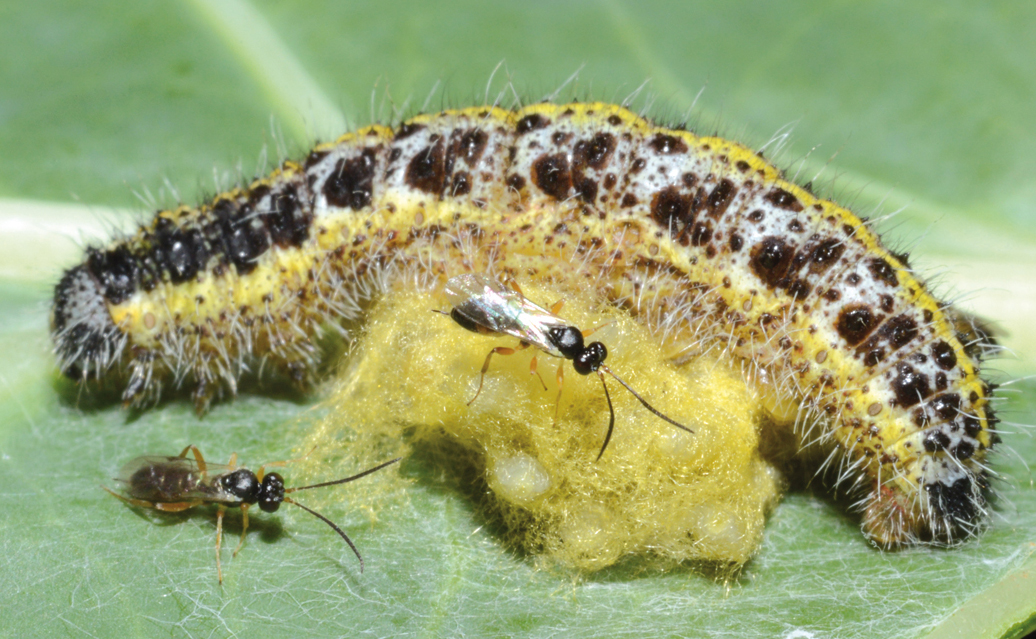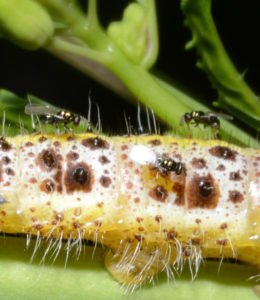Parasitic wasps in turn are attacked by other parasitic wasps. These hyperparasitoids lay their eggs inside the larvae of parasitic wasps when those are still inside their herbivore host or lay eggs in/on pupae of parasitic wasps when they left the herbivore to spin their silk cocoon. Since their hosts are not only hidden in a plant community but also are frequently inside a herbivore, they may be very difficult to find. I study how hyperparasitoids locate the parasitic wasps and how the interaction network of the plant, herbivore, parasitic wasp and hyperparasitoid is structured and functions.
 The secondary hyperparasitoid Lysibia nana lays its eggs inside the pupae of parasitoids of the genus Cotesia. It is the most abundant hyperparasitoid in the community of about ten hyperparasitoid species that attack Cotesia. The hyperparasitoids are remarkably effective in locating the parasitoid larvae that seem inconspicuous when developing inside the body of the caterpillar. However, when a parasitoid parasitizes the caterpillar, it affects the physiology of the caterpillar and in turn this parasitized caterpillar induces changes in plant volatile emission when it feeds on the plant. The plant odours differ between plants damaged by parasitized and unparasitized caterpillars. The hyperparasitoids use these plant odours to locate plants infested with the parasitized caterpillars and wait until the parasitoid larvae egress from the caterpillar and spin silk cocoons. At that time the hyperparasitoid lays its egg on the pupa of the parasitoid and will develop on the tissues of the parasitoid pupa. We identified that parasitized caterpillars differ in the composition of their saliva, compared to unparasitized caterpillars. These differences include activity in elicitors of plant responses to caterpillar feeding and cause the changes in plant volatile emission. We long thought that the parasitoid larvae were driving the changes in the caterpillar, but were surprised to identify that mutualistic polydnaviruses of the parasitoid were causing the changes in caterpillar physiology. The parasitoid benefits from the virus as it suppresses the caterpillar immune system, whereas the virus uses the parasitoid for its replication. The virus not only suppresses the caterpillar immune system, but is also responsible for the changes in the composition of caterpillar saliva. Many parasitoid species carry polydnavirusses and we are currently exploring if and how viruses play a role in other plant-caterpillar-parasitoid systems.
The secondary hyperparasitoid Lysibia nana lays its eggs inside the pupae of parasitoids of the genus Cotesia. It is the most abundant hyperparasitoid in the community of about ten hyperparasitoid species that attack Cotesia. The hyperparasitoids are remarkably effective in locating the parasitoid larvae that seem inconspicuous when developing inside the body of the caterpillar. However, when a parasitoid parasitizes the caterpillar, it affects the physiology of the caterpillar and in turn this parasitized caterpillar induces changes in plant volatile emission when it feeds on the plant. The plant odours differ between plants damaged by parasitized and unparasitized caterpillars. The hyperparasitoids use these plant odours to locate plants infested with the parasitized caterpillars and wait until the parasitoid larvae egress from the caterpillar and spin silk cocoons. At that time the hyperparasitoid lays its egg on the pupa of the parasitoid and will develop on the tissues of the parasitoid pupa. We identified that parasitized caterpillars differ in the composition of their saliva, compared to unparasitized caterpillars. These differences include activity in elicitors of plant responses to caterpillar feeding and cause the changes in plant volatile emission. We long thought that the parasitoid larvae were driving the changes in the caterpillar, but were surprised to identify that mutualistic polydnaviruses of the parasitoid were causing the changes in caterpillar physiology. The parasitoid benefits from the virus as it suppresses the caterpillar immune system, whereas the virus uses the parasitoid for its replication. The virus not only suppresses the caterpillar immune system, but is also responsible for the changes in the composition of caterpillar saliva. Many parasitoid species carry polydnavirusses and we are currently exploring if and how viruses play a role in other plant-caterpillar-parasitoid systems.
 By using plant volatiles, hyperparasitoids can identify plants on which parasitized caterpillars feed. However, these parasitized caterpillars often feed side by side with unparasitized caterpillars. We found that the primary hyperparasitoid Baryscapus galactopus can discriminate between the body odours of parasitized and unparasitized caterpillars. Baryscapus is a tiny hyperparasitoid that parasitizes the larvae of Cotesia when they are still developing inside the caterpillar body. To parasitize the Cotesia larvae, Baryscapus first penetrates the skin of the caterpillar with its ovipositor. Then the ovipositor elongates as a telescope and can be moved inside the caterpillar body in search for the parasitoid larvae. When hitting a larva, the ovipositor is moved into the larvae and multiple eggs are deposited in the Cotesia larva. When the Cotesia larvae egress from the caterpillar and spin their silk cocoon, the eggs of Baryscapus inside the body of the parasitoid larvae hatch. They develop on the expense of the Cotesia larvae and out of the parasitoid cocoon, up to six Baryscapus emerge. We are currently addressing how various hyperparasitoids compete over Cotesia larvae and how hyperparasitoids locate parasitized caterpillars in biodiverse insect communities.
By using plant volatiles, hyperparasitoids can identify plants on which parasitized caterpillars feed. However, these parasitized caterpillars often feed side by side with unparasitized caterpillars. We found that the primary hyperparasitoid Baryscapus galactopus can discriminate between the body odours of parasitized and unparasitized caterpillars. Baryscapus is a tiny hyperparasitoid that parasitizes the larvae of Cotesia when they are still developing inside the caterpillar body. To parasitize the Cotesia larvae, Baryscapus first penetrates the skin of the caterpillar with its ovipositor. Then the ovipositor elongates as a telescope and can be moved inside the caterpillar body in search for the parasitoid larvae. When hitting a larva, the ovipositor is moved into the larvae and multiple eggs are deposited in the Cotesia larva. When the Cotesia larvae egress from the caterpillar and spin their silk cocoon, the eggs of Baryscapus inside the body of the parasitoid larvae hatch. They develop on the expense of the Cotesia larvae and out of the parasitoid cocoon, up to six Baryscapus emerge. We are currently addressing how various hyperparasitoids compete over Cotesia larvae and how hyperparasitoids locate parasitized caterpillars in biodiverse insect communities.
